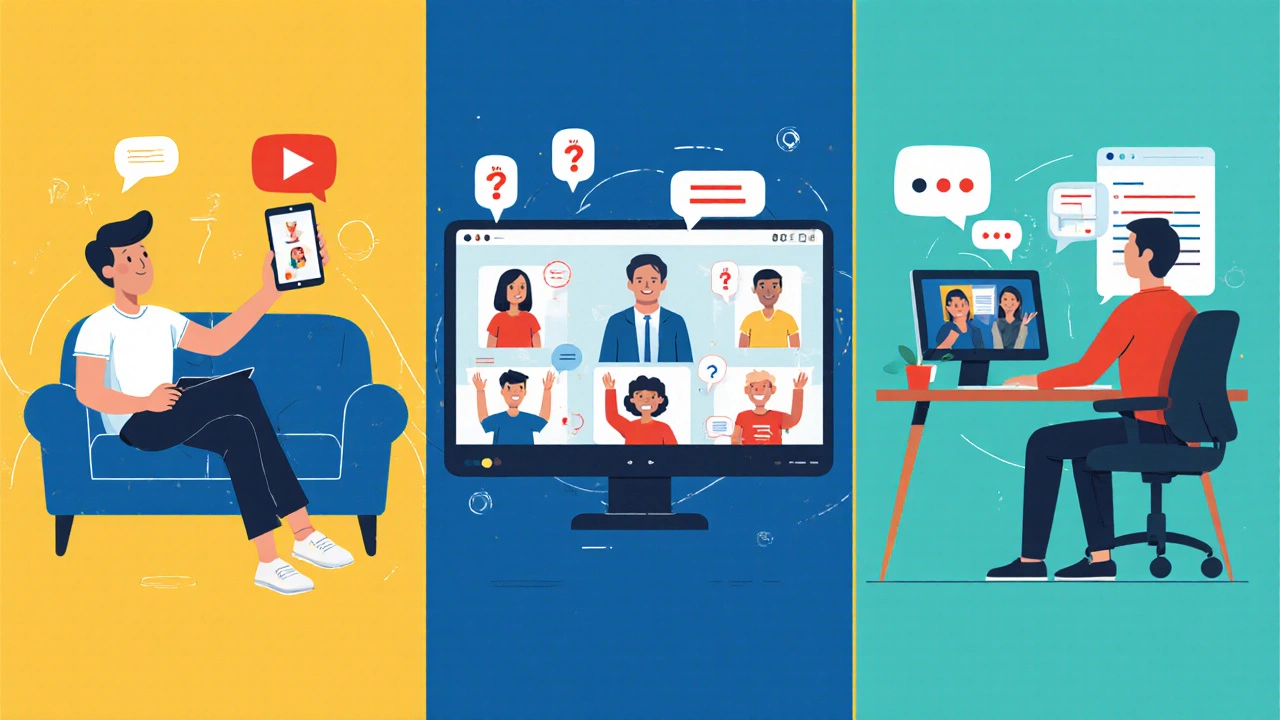eLearning Type Selector
Find the best eLearning format for your needs
Answer a few questions to get personalized recommendations based on your specific goals and constraints.
Your Learning Scenario
Recommended eLearning Type
Why this is the best fit
When you hear the word eLearning is a digital learning approach that delivers educational content via the internet, often using interactive tools and multimedia, you might picture a video tutorial or a massive open course. In reality, eLearning spans many formats, each suited to different learning goals, budgets, and time constraints. Understanding the three main types helps you pick the right fit without drowning in jargon.
Why the Distinction Matters
Different organizations-schools, corporations, NGOs-use eLearning for distinct reasons. Some need rapid skill upgrades, others require deep engagement and real‑time feedback. By matching the learning style to your objective, you avoid wasted resources and boost completion rates.
The Three Main Types of eLearning
Broadly, eLearning falls into three categories: self‑paced, instructor‑led, and blended. Each type blends technology, human interaction, and content delivery in a unique way.
1. Self‑Paced eLearning
Self‑paced courses let learners move through material on their own schedule. Content usually lives inside a Learning Management System (LMS) a software platform that hosts courses, tracks progress, and issues certificates. Learners watch videos, complete quizzes, and interact with simulations whenever they have a spare 10 minutes.
- Typical use cases: compliance training, onboarding, skill‑based certifications.
- Pros: scalable, low instructor cost, flexible for distributed teams.
- Cons: limited real‑time feedback, higher dropout risk without motivation.
2. Instructor‑Led eLearning (ILE)
Instructor‑led eLearning mirrors a traditional classroom but moves it online. A live instructor streams lessons, runs breakout discussions, and answers questions in real time. Platforms often use Massive Open Online Courses (MOOCs) large‑scale courses offered by universities or companies, typically open to anyone with internet access technology for live webinars and interactive polls.
- Typical use cases: professional development workshops, graduate‑level seminars, corporate leadership programs.
- Pros: high engagement, immediate clarification, community building.
- Cons: scheduling constraints, higher facilitator fees, limited scalability.
3. Blended (Hybrid) eLearning
Blended eLearning combines self‑paced modules with scheduled instructor sessions. The design often follows the Adaptive Learning technology that adjusts content difficulty based on learner performance and behavior model, delivering personalized pathways while still offering live mentorship.
- Typical use cases: university courses, certification programs that require both theory and practice, corporate training requiring on‑the‑job application.
- Pros: balanced flexibility, higher retention, tailored learning journeys.
- Cons: more complex design, need for both LMS and live‑video infrastructure.
Side‑by‑Side Comparison
| Attribute | Self‑Paced | Instructor‑Led | Blended |
|---|---|---|---|
| Delivery Mode | Asynchronous | Synchronous (live) | Mix of asynchronous & synchronous |
| Interaction Level | Low (forums, automated quizzes) | High (live Q&A, breakout rooms) | Medium to high (self‑study + live sessions) |
| Typical Platform | LMS, SCORM packages | Webinars, MOOC tools | LMS + video conferencing |
| Scalability | Very high | Limited by instructor bandwidth | High but requires coordination |
| Best For | Compliance, quick up‑skilling | Leadership, complex concepts | Comprehensive certifications |
Supporting Technologies and Standards
Modern eLearning rarely lives in isolation. Standards like SCORM Sharable Content Object Reference Model, a set of specifications that enable interoperability between learning content and LMSs ensure modules can be reused across platforms. The newer xAPI (Tin Can) an API that captures detailed learning activity data beyond traditional SCORM tracking opens doors for analytics dashboards and personalized nudges.
Microlearning-a practice of delivering bite‑sized lessons-fits naturally within self‑paced formats, while immersive simulations often rely on the adaptive engine mentioned earlier.

Choosing the Right Type for Your Goals
- Define the learning objective. If the goal is simple knowledge recall, self‑paced may suffice.
- Assess audience constraints. Global teams across time zones benefit from asynchronous content.
- Consider budget and resources. Live instructors add cost; blended needs both tech and talent.
- Plan for measurement. Use SCORM for basic completion tracking or xAPI for detailed behavior analytics.
- Prototype and test. Launch a pilot module in each format, then compare engagement metrics.
By following these steps, you can match the eLearning type to the real business need rather than a one‑size‑fits‑all assumption.
Implementation Tips
- Start with a solid LMS. Choose a system that supports SCORM, xAPI, and responsive design.
- Leverage existing content. Convert classroom slides into microlearning videos to save production time.
- Incorporate assessments early. Short quizzes after each module improve retention.
- Use analytics. Track completion rates, time‑on‑task, and knowledge gains to refine the approach.
- Gather feedback. Post‑course surveys help identify gaps in interaction or content relevance.
Common Pitfalls to Avoid
Even seasoned eLearning teams stumble over a few traps:
- Overloading content. Long videos and dense text cause fatigue; break them into 5‑10 minute chunks.
- Neglecting interaction. Purely passive courses see higher dropout-add polls, scenarios, or discussion boards.
- Skipping accessibility. Ensure captions, screen‑reader compatibility, and color contrast meet WCAG 2.1 standards.
- Underestimating technical needs. Bandwidth issues can cripple live sessions; provide downloadable assets as fallback.
Future Trends Shaping eLearning Types
Artificial intelligence is powering hyper‑personalized pathways, blurring the line between self‑paced and instructor‑led. Virtual reality simulations are emerging as stand‑alone modules, especially for safety‑critical training, while blockchain credentials are making completion verification immutable.
Staying aware of these trends ensures your eLearning strategy remains competitive, whether you stick to a single type or evolve into a hybrid ecosystem.
Quick Checklist for Launching Your eLearning Program
- Identify clear learning outcomes.
- Select the eLearning type that aligns with those outcomes.
- Choose an LMS that supports SCORM and xAPI.
- Develop content in bite‑sized modules (5‑10 minutes each).
- Integrate assessments and analytics from day one.
- Run a pilot, gather data, iterate.
Frequently Asked Questions
What is the main difference between self‑paced and instructor‑led eLearning?
Self‑paced eLearning lets learners study whenever they want, using pre‑recorded videos and quizzes, while instructor‑led eLearning involves live sessions where a teacher interacts in real time.
Can I mix the three types in a single program?
Yes, blended learning is precisely that mix-self‑paced modules paired with scheduled live workshops to get the best of both worlds.
Do I need a special LMS for blended learning?
A modern LMS that supports both SCORM/xAPI and integrates with video‑conferencing tools (Zoom, Teams) will handle blended courses smoothly.
How can I keep learners engaged in self‑paced courses?
Add interactive elements like drag‑and‑drop activities, short quizzes after each segment, and gamified badges to motivate progress.
What standards should I follow to ensure my eLearning content works across platforms?
Stick to SCORM for basic compatibility and xAPI if you need detailed tracking; both are widely supported by major LMS vendors.



